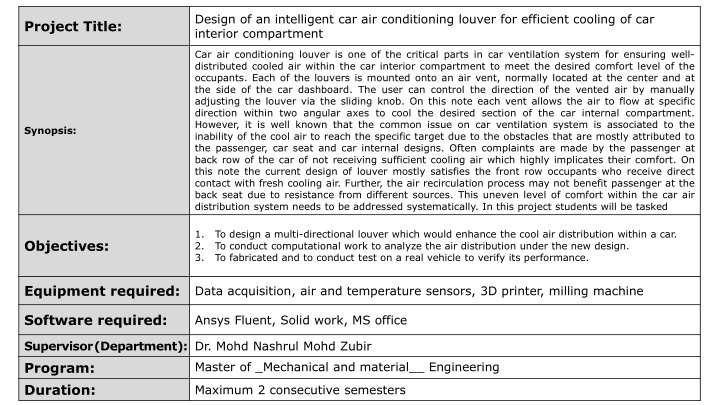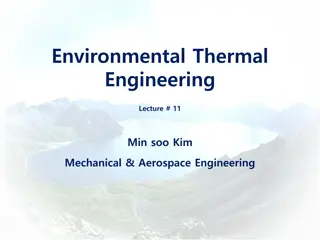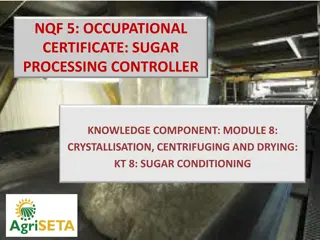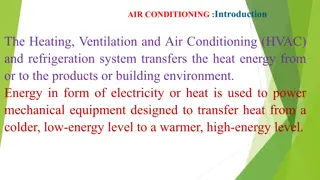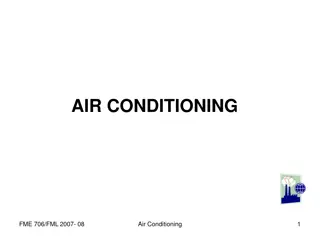Intelligent Car Air Conditioning Louver Design
Car air conditioning louvers play a crucial role in distributing cooled air efficiently within a car's interior. This project aims to design a multi-directional louver to enhance air distribution, analyze its performance computationally, and conduct real vehicle testing. By addressing uneven cooling levels, the project seeks to improve passenger comfort systematically.
Uploaded on Mar 07, 2025 | 2 Views
Download Presentation

Please find below an Image/Link to download the presentation.
The content on the website is provided AS IS for your information and personal use only. It may not be sold, licensed, or shared on other websites without obtaining consent from the author.If you encounter any issues during the download, it is possible that the publisher has removed the file from their server.
You are allowed to download the files provided on this website for personal or commercial use, subject to the condition that they are used lawfully. All files are the property of their respective owners.
The content on the website is provided AS IS for your information and personal use only. It may not be sold, licensed, or shared on other websites without obtaining consent from the author.
E N D
Presentation Transcript
Design of an intelligent car air conditioning louver for efficient cooling of car interior compartment Project Title: Car air conditioning louver is one of the critical parts in car ventilation system for ensuring well- distributed cooled air within the car interior compartment to meet the desired comfort level of the occupants. Each of the louvers is mounted onto an air vent, normally located at the center and at the side of the car dashboard. The user can control the direction of the vented air by manually adjusting the louver via the sliding knob. On this note each vent allows the air to flow at specific direction within two angular axes to cool the desired section of the car internal compartment. However, it is well known that the common issue on car ventilation system is associated to the inability of the cool air to reach the specific target due to the obstacles that are mostly attributed to the passenger, car seat and car internal designs. Often complaints are made by the passenger at back row of the car of not receiving sufficient cooling air which highly implicates their comfort. On this note the current design of louver mostly satisfies the front row occupants who receive direct contact with fresh cooling air. Further, the air recirculation process may not benefit passenger at the back seat due to resistance from different sources. This uneven level of comfort within the car air distribution system needs to be addressed systematically. In this project students will be tasked Synopsis: 1. 2. 3. To design a multi-directional louver which would enhance the cool air distribution within a car. To conduct computational work to analyze the air distribution under the new design. To fabricated and to conduct test on a real vehicle to verify its performance. Objectives: Equipment required: Data acquisition, air and temperature sensors, 3D printer, milling machine Software required: Ansys Fluent, Solid work, MS office Supervisor(Department): Dr. Mohd Nashrul Mohd Zubir Program: Master of _Mechanical and material__ Engineering Duration: Maximum 2 consecutive semesters
Investigation of the synergistic effect of internal surface microgrooving on heat transfer tube and colloid based heat transfer media for enhanced thermal management of heat exchanger Project Title: Researchers have been persistently working on finding an innovative solution to cope with the ever- increasing demand of high heat flux cooling and heating operations. One of the prospective approaches is to gain control over the boundary layer domain where heat and mass transfer dominates. In this context, most researchers have adopted passive technique in order to modulate the boundary layer. This technique involves the use of either surface profile alteration, insertion of flow swirling devices and modifying fluid properties. However, its application within thermal engineering perspective has been overshadowed by the associative complication to the overall system performance. Thus, the focus of the present work is to introduce a hybrid passive approach via the use of surface profile alteration and fluid property modification to improve heat transfer performance under convective mode. Specifically, a tube with structured surface in the form of microgrooves will be used together with a highly conductive solid additive to gain enhanced heat transfer in comparison to the conventional heat transfer liquid. Synopsis: 1. 2. 3. To perform surface modification of the heat exchanger tube To conduct experimental work on heat transfer performance To conduct computational work to analyze the heat transfer performance between conventional and proposed method Objectives: Data acquisition (available) , heat transfer experimental set-up(available), copper tube Equipment required: Software required: Ansys Fluent, Solid work, MS office Supervisor(Department): Dr. Mohd Nashrul Mohd Zubir Program: Master of _Mechanical and material__ Engineering Duration: Maximum 2 consecutive semesters
Application of metal oxide thin film on structured heat exchanger surface for enhancing heat transfer and fouling mitigation Project Title: One of the persisting challenges in heat exchanger design is to consider the lifespan operation and drop in performance due to fouling deposition which can come from either mineral or biological forms. One of the promising avenues to address the above problem is through the use of coating technology to form a protective film on the heat exchange surface to delay and remove the scaling deposition. Several metal oxide materials which are known to be non-reactive to calcium ion will be coated via advanced deposition method. Moreover the thin film also serves to disrupt the formation of nucleation sites with the help of turbulent boundary layer mixing near the heat exchanger surface. In this project the candidate shall modify the surface of texture of different metal tubes which represent the heat exchanger. These specimens will be coated using highly selected metal oxide using plasma coating technology and tested under fouling environment via the use the existing heat exchanger fouling facility. The student shall perform comparative study on the effectiveness of different coating materials to mitigate and prevent fouling deposition. Analysis shall be conducted empirically via the use of classical heat transfer analysis. Synopsis: 1. 2. 3. To perform surface modification of the heat exchanger tube To conduct experimental work on fouling retardation and heat transfer performance To conduct computational work to analyze the heat transfer performance between commercial and newly devised tube surface Objectives: Data acquisition (available) , Fouling/heat transfer experimental set-up(available), copper tube Equipment required: Software required: Ansys Fluent, Solid work, MS office Supervisor(Department): Dr. Mohd Nashrul Mohd Zubir Program: Master of _Mechanical and material__ Engineering Duration: Maximum 2 consecutive semesters
Project Title: Design of heat and mass heat exchanger for indirect evaporative cooling Over the years, the energy consumed for satisfying thermal comfort in both enclosed and open spaces has rapidly increased. Studies have shown that buildings consume up to 40% of the total global energy and by the year 2030, the consumption is expected to increase to 50%. In Malaysia alone, buildings consume a total of 48% of the electricity generated in the country. The underpinning reason behind this substantial amount of energy usage stems from the use of vapor-compression cycle to absorb heat generated within the space. On this note, compression stage of the cycle consumes almost 90% of the total work in into the system, with the remaining consists of evaporator and condenser fans. Different approaches have been brought forward to eliminate the use of compressor which translates into reduction of the total energy usage in air-conditioning system. On this note researches have shown that as much as 80% decrease in energy input has been achieved via evaporative cooling concept relative to the conventional vapor-compression cooling method. In Malaysia s perspective, indirect evaporative cooling strategy is most suitable to be adopted in comparison to direct evaporative cooling to avoid excessive increase in relative humidity associated with the evaporation process. This require the use of heat and mass exchanger (HMX) to isolate moisture rich working air from the conditioned air during the cooling process. Synopsis: 1. To develop heat and mass exchanger based on passive-active heat transfer augmentation approach. To perform experimental study on the performance of the new approach relative to conventional method. To conduct numerical study to validate the experimental finding Objectives: 2. 3. Data acquisition, ultrasonic vibrator, ultrasonic atomizer, pump and flowmeter, stainless steel plate, electrical components, fan, motor control Equipment required: Software required: Ansys Fluent, MS office Supervisor(Department): Dr. Mohd Nashrul Mohd Zubir Program: Duration: Master of _Mechanical and material__ Engineering Maximum 2 consecutive semesters
Project Title: Improving thermal heat dissipation from solar panel via high performance colloidal liquid It is well know that one of the main issues plaguing solar PV from reaching its optimum operation is maintaining the panel temperature which translate into better energy conversion efficiency. Enjoying the bright sunny day comes at a cost of overheating the panel and this will offset the peak energy gain during this time. Thus the current work would deal on designing a heat exchanger capable of removing the heat as well as storing this heat for water heating supply. The heat exchanger will be running with liquid refrigerant coupled with highly conductive solid additive to improve the dissipation performance. Study will focus on finding the best combination of flow and refrigerant properties to help improving panel performance. An actual site test will be conducted to gauge the feasibility and ability of the system to improve the PV performance while taking benefit from the supplying the heated water for domestic use 1. To develop heat exchange that can be incorporated to solar panel 2. To conduct experimental work on heat transfer performance using nanocolloidal refrigerant 3. To conduct site test on the heat dissipation performance and heated water supply limit Data acquisition, pump and flowmeter, stainless steel plate, electrical components, fan, motor control Synopsis: Objectives: Equipment required: Software required: Ansys Fluent, MS office Supervisor(Department): Dr. Mohd Nashrul Mohd Zubir Program: Duration: Master of _Mechanical and material__ Engineering Maximum 2 consecutive semesters
